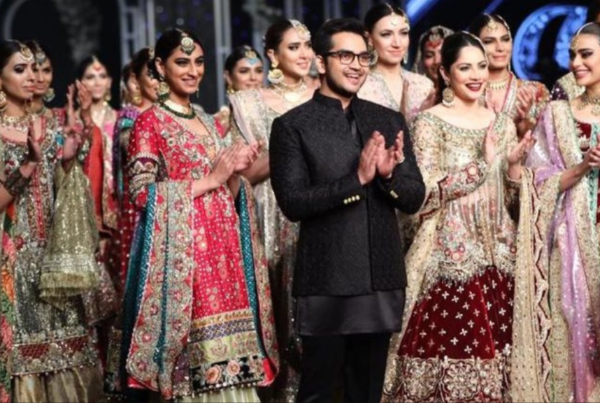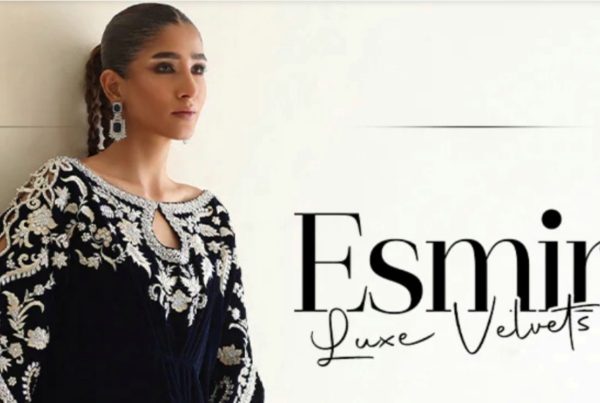The new format wasn’t easy on high heeled feet; stilettos were quickly replaced by flat albeit fashionably studded sneakers. The benches had some people complaining about their unsupported backs but those people quickly plastered beaming smiles on their faces as there’s nothing worse in fashion than giving away your age. Plus, the Sunsilk Survivor Kits did contain a strip of painkillers for silent sufferers. But enough about the logistics.
The PFDC Sunsilk Fashion Week 2017, now in its eighth year, officially marked the end of the usual grandiose gala that aimed to entertain high society doyennes. It was the end of fashion boot camp, where one was compelled to sit through an endless array of good and bad collections. Celebrities were (more or less) restricted to the front rows with only the weaker collections hitch hiking on stars for 10 seconds of fame. PSFW put the spotlight on fashion and then allowed the designers to do their best.
Here’s how. Instead of one runway, fashion week this year featured two catwalks, where collections were rolled out alternately. It enabled people to get up and leave if they didn’t want to catch the next show, it allowed them a break between shows had they opted to stay and the transition – mostly seamless – ensured that time was conserved between shifts. There were no endless reels of advertisements, channel promotions or even designer AVs before the shows; the clutter was minimized and the noise deafened out. It was a relief to not have to watch promos of TV dramas on the loop – Urdu One the media partner got it right this time – and it was just as pleasant to not have to sit through self-indulgent videos put together by designers.
The Pakistan Fashion Design Council put the system in place and then handed the key to designers. Some of them made a grand entry, some of them fell in unceremoniously and others – unfortunately some big names – decided to sit it out.

Misha Lakhani’s use of hand woven fabric to create modern and sophisticated silhouettes was flawless.
There were several brands that impressed with cohesive, well thought out and innovative collections. Misha Lakhani showcased one of the strongest collections of day one; her use of hand woven fabric to create modern and sophisticated silhouettes was flawless. Khadijah Rehman for Generation took her stream of consciousness to the festival of basant and used the craft of kite making to construct clothes. It was quite brilliant and deserved every bit of the Lux Style Award she won for Best High Street Brand on Wednesday. Sania Maskatiya showcased an understated and very cruise appropriate collection for the debut of Sania Studio, her line of adaptable western clothing. Hassan Sheheryar Yasin, who opened fashion week with a collection called Paranoia, collaborated with two young artists and his accessories were standout and quite desirable.
High street brands were given the chance to put their best foot forward on day two; the day swung between luxury apparel and casual ready to wear with some established names like Amir Adnan, Tena Durrani, Saira Rizwan, Shiza Hassan and finally Sapphire drawing in fashion enthusiasts. Amir Adnan stuck to his signature formal groom’s wear while Tena Durrani played with her signature fusion. Saira Rizwan showed a summer appropriate collection while Shiza Hassan dabbled in luxury that was, once again, very spring/summer for luxury wear. The highlight of the day was Sapphire, the mega brand that made a PSFW debut this year. It will be interesting to see how Khadijah Shah, Creative Director at Sapphire, adapts this fashion week collection for the mass market. She took the final walk of fame with Akif Mahmood, an extremely promising young designer who rose to fame on this very platform years ago, and appeared to have finally settled down at Sapphire.

Ali Xeeshan’s finale had a larger than life element that drew his ode to the underachiever into artistic peripheries.
A bit of quality compromise was made on most high street brands; it was difficult to imagine how some of the collections had cleared the council’s usual discerning eye and approval. This also brings me to a second case in point: who wears micro-skirts in Pakistan? While luxury brands like Sana Safinaz, Elan and Shehla Chatoor do have a niche clientele for western wear, one struggles to understand how high street brands can afford to be culturally inappropriate? Would some of the designs that these brands showed as part of their collections actually retail in their stores? Some creative licensing is allowed for the catwalk but a brand like Ethnic by Outfitters showing a model wearing a tiny (almost skanky, pardon the inappropriateness of the term) red tank top covered by a black net tee shirt was confusing. This kind of free hand with ‘show whatever’ had never been an issue at PSFW before.
The Sunsilk Hair Trends showcase by Nabila, however, was one of the highest points of the entire fashion week. Nabila is a master craftsman when it comes to creativity in hair and she is just as much a perfectionist, evident in the attention that was paid to details. This was bespoke, couture hair and it did rise, gloss, colour, braid and curl to the occasion.
The third and last day of fashion week actually did continue on a high note. There was a spectacular collection from Khaadi Khaas, exhibiting the perfect way to make traditional apparel relevant in this day and global age. Sana Safinaz played with their landmark luxury and they played to their clientele. It was a bit repetitive but it was quintessential Sana Safinaz and it worked. Adnan Pardesy flaunted his expertise with bespoke detailing even though his palette and silhouettes were a bit too safe. Asifa Nabeel also presented a stable and safe collection. The only menswear designer of the day, Omar Farooq tapped into a minimalist, Japanese ethos for inspiration and as always, it impressed. The Ali Xeeshan finale was just as befitting as one expected it to be; there was a larger than life element that drew his ode to the underachiever into artistic peripheries.

Sapphire upped the high street fashion ante with this collection.
Based on the content, fashion week could be termed a success even though it would have swept the stakes had designers participated in full capacity. There was no Sara Shahid, Zara Shahjahan, Maheen Kardar Ali and many others that one has grown accustomed to seeing and appreciating on this platform. One has said this before and it has to be said again: Pakistan needs one united platform to flaunt the best of its talent. Divided platforms simply dilute the collective brand value of Pakistani fashion.
This year fashion week also brought in a new show director and Sadia Siddiqui did succeed in bringing in an international standard and vitally, discipline. The idea of having two separate show areas was evolutionary; execution of course needed work. Entry and exit points could have been better; the inconvenience of exiting all the way out and around the Expo for reentry was exhausting and unnecessary. The entry channel to each show area, with high intensity flash lights was a little more concentration camp than fashion week. The ‘no-stag’ policy was a little odd considering it was fashion week and it is populated by a flamboyant breed of men; luckily the fashion creatures all managed to find chaperones and the oglers were minimized. The lighting, most of all, was weak and often compromised the quality of the clothes and their photographs.
Change is part of growth and evolution will always come with a window or errors. The important thing is that platforms should continue to evolve and grow and learn from mistakes, minimizing their repetition. Perfection will eventually be a by-product of consistency and the vision to improve.
- Photography by Faisal Farooqui and the team at Dragonfly
- This review was first published in Instep on Sunday, April 23 2017




